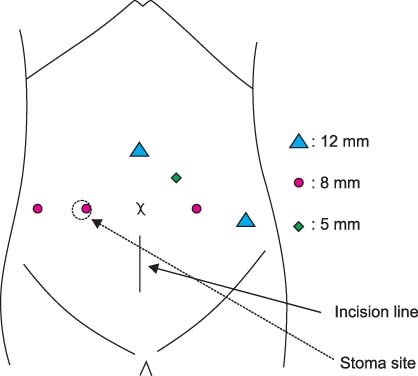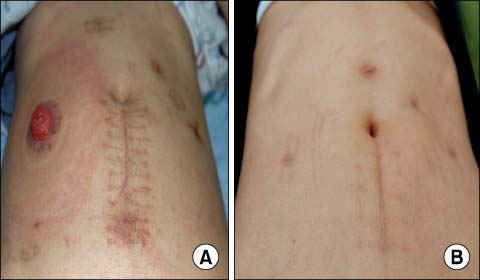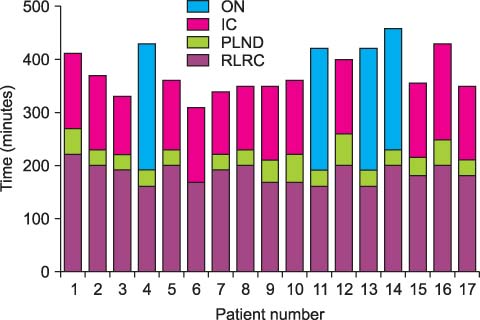Korean J Urol.
2010 Mar;51(3):178-182.
Initial Experiences with Robot-Assisted Laparoscopic Radical Cystectomy
- Affiliations
-
- 1Department of Urology, School of Medicine, Kyungpook National University, Daegu, Korea. tgkwon@knu.ac.kr
Abstract
- PURPOSE
Robot-assisted laparoscopic radical cystectomy (RLRC) is a new option for the treatment of muscle-invasive bladder cancer, and case series for RLRC have been increasing recently. We report our operative technique and initial experiences with RLRC with extracorporeal urinary diversion. MATERIALS AND METHODS: Between October 2008 and November 2009, 17 consecutive patients with muscle-invasive bladder cancer underwent RLRC, pelvic lymph node dissection, and extracorporeal urinary diversion. Urinary diversion included 13 ileal conduits and 4 orthotopic neobladders (Studer method). Data were collected prospectively on patient demographics, intraoperative parameters, pathologic staging, and postoperative outcomes. RESULTS: The mean patient age was 63.7 years. The mean body mass index was 22.6 kg/m2. No patients had a history of previous abdominal surgery. The mean operative time was 379.1 minutes, including 32.6 minutes for pelvic lymph node dissection, 185.2 minutes for RLRC, and 159.4 minutes for urinary diversion. The mean estimated blood loss was 210.5 ml. The mean hospital stay was 20.7 days and the mean time to oral intake and ambulation was 5.0 and 1.3 days, respectively. There were no major perioperative complications. The pathologic reports showed urothelial cell carcinomas in all cases. CONCLUSIONS: Our initial clinical experiences indicate that RLRC with pelvic lymph node dissection and extracorporeal urinary diversion is a safe and feasible procedure with minimal blood loss and rapid recovery. Long-term follow up in a larger patient population is needed to determine the true oncological and functional benefit of this procedure.
Keyword
MeSH Terms
Figure
Reference
-
1. Stein JP, Lieskovsky G, Cote R, Groshen S, Feng AC, Boyd S, et al. Radical cystectomy in the treatment of invasive bladder cancer: long-term results in 1,054 patients. J Clin Oncol. 2001. 19:666–675.2. Herr HW, Bochner BH, Dalbagni G, Donat SM, Reuter VE, Bajorin DF. Impact of the number of lymph nodes retrieved on outcome in patients with muscle invasive bladder cancer. J Urol. 2002. 167:1295–1298.3. Simonato A, Gregori A, Lissiani A, Bozzola A, Galli S, Gaboardi F. Laparoscopic radical cystoprostatectomy: our experience in a consecutive series of 10 patients with a 3 years follow-up. Eur Urol. 2005. 47:785–790.4. DeGer S, Peters R, Roigas J, Wille AH, Tuerk IA, Loening SA. Laparoscopic radical cystectomy with continent urinary diversion (rectosigmoid pouch) performed completely intracorporeally: an intermediate functional and oncologic analysis. Urology. 2004. 64:935–939.5. Haber GP, Colombo JR Jr, Aron M, Ukimura O, Gill IS. Laparoscopic radical cystectomy and urinary diversion: status in 2006. Eur Urol. 2006. 5:Suppl. 950–955.6. Haber GP, Crouzet S, Gill IS. Laparoscopic and robotic assisted radical cystectomy for bladder cancer: a critical analysis. Eur Urol. 2008. 54:54–62.7. Kang SC, Kang SG, Choi H, Ko YH, Lee JG, Kim JJ, et al. The feasibility of robot-assisted laparoscopic radical cystectomy with pelvic lymphadenectomy: from the viewpoint of extended pelvic lymphadenectomy. Korean J Urol. 2009. 50:870–878.8. Park SY, Cho KS, Park KK, Park SJ, Ham WS, Rha KH. Robot-assisted laparoscopic radical cystectomy with ileal conduit urinary diversion. Korean J Urol. 2008. 49:506–509.9. Guru KA, Kim HL, Piacente PM, Mohler JL. Robot-assisted radical cystectomy and pelvic lymph node dissection: initial experience at Roswell Park Cancer Institute. Urology. 2007. 69:469–474.10. Menon M, Hemal AK, Tewari A, Shrivastava A, Shoma AM, EL-Tabey NA, et al. Nerve-sparing robot-assisted radical cystoprostatectomy and urinary diversion. BJU Int. 2003. 92:232–236.11. Elhage O, Murphy D, Challacombe B, Shortland A, Dasgupta P. Ergonomics in minimally invasive surgery. Int J Clin Pract. 2007. 61:186–188.12. Rhee JJ, Lebeau S, Smolkin M, Theodorescu D. Radical cystectomy with ileal conduit diversion: early prospective evaluation of the impact of robotic assistance. BJU Int. 2006. 98:1059–1063.13. Pruthi RS, Wallen EM. Robotic assisted laparoscopic radical cystoprostatectomy: operative and pathological outcomes. J Urol. 2007. 178:814–818.14. Beecken WD, Wolfram M, Engl T, Bentas W, Probst M, Blaheta R, et al. Robotic-assisted laparoscopic radical cystectomy and intra-abdominal formation of an orthotopic ileal neobladder. Eur Urol. 2003. 44:337–339.15. Sala LG, Matsunaga GS, Corica FA, Ornstein DK. Robot-assisted laparoscopic radical cystoprostatectomy and totally intracorporeal ileal neobladder. J Endourol. 2006. 20:233–235.16. Cathelineau X, Jaffe J. Laparoscopic radical cystectomy with urinary diversion: what is the optimal technique ? Curr Opin Urol. 2007. 17:93–97.17. El-Tabey NA, Shoma AM. Port site metastases after robot-assisted laparoscopic radical cystectomy. Urology. 2005. 66:1110.18. Rassweiler J, Tsivian A, Kumar AV, Lymberakis C, Schulze M, Seeman O, et al. Oncological safety of laparoscopic surgery for urological malignancy: experience with more than 1,000 operations. J Urol. 2003. 169:2072–2075.
- Full Text Links
- Actions
-
Cited
- CITED
-
- Close
- Share
- Similar articles
-
- Robot-Assisted Laparoscopic Radical Cystectomy
- Erratum: Robot-Assisted Laparoscopic Radical Prostatectomy
- Robot-assisted Laparoscopic Radical Cystectomy with Ileal Conduit Urinary Diversion
- A Case of Robot-Assisted Laparoscopic Radical Prostatectomy in Primary Small Cell Prostate Cancer
- The Feasibility of Robot-Assisted Laparoscopic Radical Cystectomy with Pelvic Lymphadenectomy: from the Viewpoint of Extended Pelvic Lymphadenectomy




